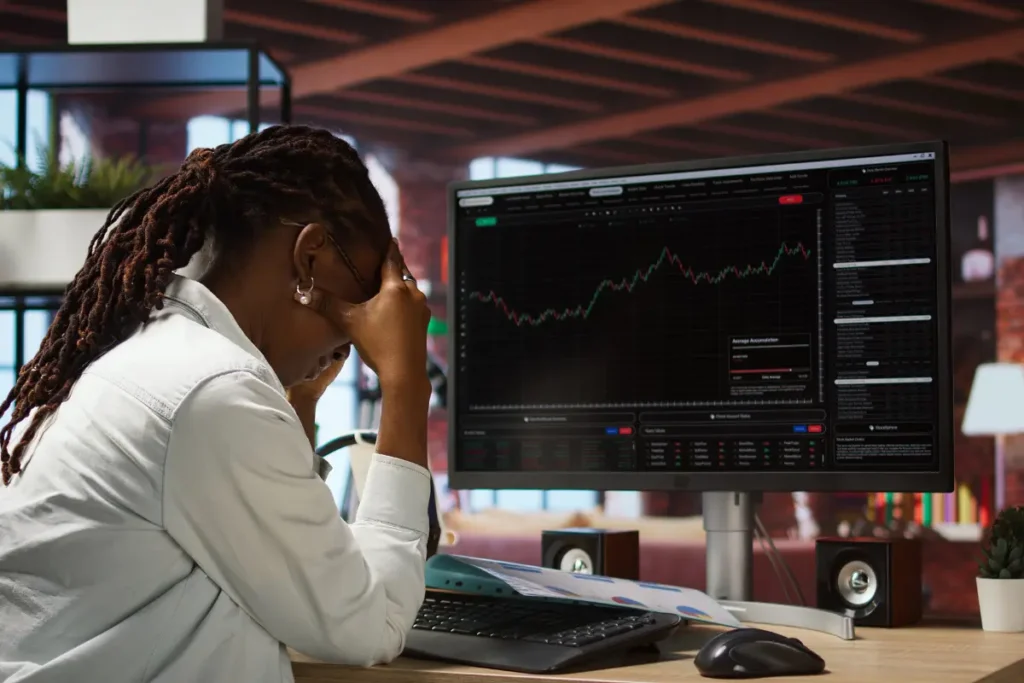The US stock market suffered a sudden and steep decline on November 5, 2025, in New York. Fears over extremely high tech valuations and disruptions in the global oil market led to the Stock Market Crash. The investors are confused about the future now, and the world markets are all watching closely. The article will explain the reasons behind the stock market crash, the main factors that played a role, and what the future holds.
Why Did the Stock Market Crash Happen?
The Stock Market Crash, which happened on November 5, 2025, was a result of a number of disturbing signs that were coming from the economy. For many months, stocks had been on an uptrend, and the earnings of many companies had been really good. But still, the main issues were being raised regarding the appropriateness of these high valuations.
Big tech companies on the one hand like Palantir and Tesla, on the other hand, continued to post impressive earnings reports but the prices they were being offered were extremely high. The analysts believed the huge price-to-earnings (P/E) ratios were an indication that the stocks were increasingly susceptible to correction. The fear of the investors that the current valuations were indeed unrealistic and therefore unsustainable led to the sell-off.

At the same time, the world oil trades were dealing with instability caused by US sanctions against Russia’s oil exports. The US sanctions were heavy on Russia, leading to a considerable drop in Russian crude shipments to the US. The shipment decline data from Bloomberg indicated a fall of 190,000 barrels per day in just four weeks of sanctions, which resulted in the market being flooded with oil, so the prices went down and the uncertainty in the market situation kept on increasing.
Investors started to think of the oil shocks’ broader economic implications. The combination of tech stocks being overvalued and the energy crisis created a perfect storm that led to the stock market crash.
Factors Contributing to the Stock Market Crash
Several factors contributed to this major market event. Here is a closer look:
| Factors | Impact | Data |
| Sky-high tech valuations | Overpriced stocks led to fears of a correction | Palantir’s stock fell over 6.8%; Tesla’s shares dropped 3% |
| Oil supply disruptions | US sanctions on Russia cut crude shipments, raising market uncertainty | Russian exports down 190,000 barrels/day; Brent crude down 1.2% to $64.23 |
| US government shutdown | Prolonged shutdown caused delays in key economic data | US shutdown reached day 35, affecting jobs reports and economic indicators |
| Investor sentiment | Fear of overvaluation and geopolitical tensions undermined confidence | Nasdaq fell 0.9%; S&P 500 slipped 0.6%; Dow dropped 0.2% |
| Hedge fund bets | Some investors bet against overheated stocks, adding pressure | Michael Burry’s firm bet against Nvidia and Palantir through put options |
These factors combined created an environment ripe for a stock market crash, shaking investor confidence worldwide.
Market Impact
The impact of the stock market crash was visible immediately. Major indexes declined sharply, reflecting widespread concern. Here is a snapshot of the market performance on that day:
| Index | Opening Level | Change from Previous Day | Percentage Change | Comment |
| Dow Jones (^DJI) | 34,200 | -67 | -0.2% | Slight decline, but significant given recent highs |
| S&P 500 (^GSPC) | 4,620 | -28 | -0.6% | Broader market decline |
| Nasdaq Composite (^IXIC) | 14,100 | -130 | -0.9% | Tech-heavy index fell sharply |
Despite the declines, some sectors still showed resilience. For example, the industrial sector, led by companies like Caterpillar, maintained gains due to demand for infrastructure and power generation equipment.

Oil Market Disruption
The oil market suffered big blows because of the US sanctions aimed at Russia’s oil exports. According to Bloomberg, the oil stranded at sea went up by 8%, while Russian exports dropped by 190,000 bpd. Consequently, Brent crude oil prices fell down to $64.23 per barrel, thereby declining by 1.2%, and WTI slipped down too, by 1.3%.
The situation in the energy sector caused global markets’ volatility to increase. China, India, and Turkey reduced their oil imports thus adding to the uncertainty. The US, on the other hand, hiked tariffs on Indian goods which further complicated the already intricate geopolitics and energy markets.
What’s Next for Investors?
Market analysts alert that the downfall of the stock market is just one more indication of a possible correction instead of a severe recession. The investors have to be careful, as the activity in the market is still quite high and the price fluctuations are still at a high level.

The following are the main things to observe:
- The corporate earnings reports to see if the valuations are justified or not.
- The Federal Reserve and government policies.
- The international disputes over energy supplies.
The crash of the stock market has scared investors, but still, there are those who consider it a good time to buy. The well-established companies and those in the good times are likely to be stable and grow slowly but surely through the infrastructure investments.
To sum up, the stock market crash of November 5, 2025, was a result of 2-3 x valuations, disruptions in oil supplies, and political tensions. The drops have not affected the economic foundations and the long-term growth of the sectors; thus, they still remain strong. It is advisable to have a mixed portfolio and to be vigilant for more market signs.
Also Read: Facial Recognition Camera at Dubai Airport in 2025: What Every Traveler Must Know?
















